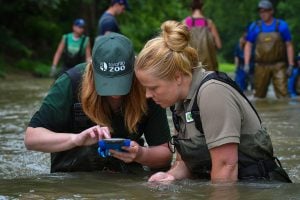
Environment
When it comes to conservation research, are zoos and aquariums doing enough?
A new study finds zoos and aquariums in Canada are publishing more peer-reviewed research, but there is still more to be done
- 1471 words
- 6 minutes
This article is over 5 years old and may contain outdated information.
Wildlife

Every night, swarms of tiny crustaceans swirl up from the bottom of the oceans to feed on algae at the surface. Although each individual organism is only a centimetre or two long, the collective motion of migrating columns of krill, brine shrimp and zooplankton may play an important role in ocean mixing, according to new research out of Stanford University.
Ocean mixing is the process by which heat, energy and nutrients like nitrogen, silica and phosphorous are redistributed throughout the layers of the ocean. The process plays a role in regulating the climate and creating the marine plant life upon which many species depend for food. Until recently, scientists shrugged off the idea that marine animals had any impact on this mixing, but the results of the Stanford study show the nightly migration of swarms of crustaceans may have an effect greater than the sum of their parts.
“If you have some small force mixing the oceans, then it could cascade into major impacts,” says Isabel Houghton, lead author of the study, which was published in the journal Nature on April 18.

Houghton and her team studied the water movement created by schools of brine shrimp in specialized tanks, using LED lights to prompt the shrimp to move upward or downward. They found that the combined swimming motion of the shrimp creates a jet powerful enough to mix waters of different density and salinity, possibly delivering nutrient-rich deep water to phytoplankton (microscopic marine plants) at the surface. “That the jets were that striking was surprising,” Houghton says.
Houghton thinks repeating the experiment with organisms like krill may show even more dramatic results. Krill are larger than brine shrimp, and their jet streams could be even stronger.

John Doward is an oceanographer at the University of Victoria who has studied the effects krill have on water mixing in Saanich Inlet in B.C. According to Doward, to effectively observe the impacts biological creatures have on ocean mixing, there needs to be more collaboration between oceanographers.
Historically, physical oceanographers have studied ocean mixing and biological oceanographers have studied organisms, and there has been little cross-collaboration on the topic. “If you can get people together, then we might have a better chance to find out how wide-spread this phenomenon really is,” Doward says.
Are you passionate about Canadian geography?
You can support Canadian Geographic in 3 ways:

Environment
A new study finds zoos and aquariums in Canada are publishing more peer-reviewed research, but there is still more to be done

People & Culture
The history behind the Dundas name change and how Canadians are reckoning with place name changes across the country — from streets to provinces

Wildlife
This past summer an ambitious wildlife under/overpass system broke ground in B.C. on a deadly stretch of highway just west of the Alberta border. Here’s how it happened.

Wildlife
An estimated annual $175-billion business, the illegal trade in wildlife is the world’s fourth-largest criminal enterprise. It stands to radically alter the animal kingdom.